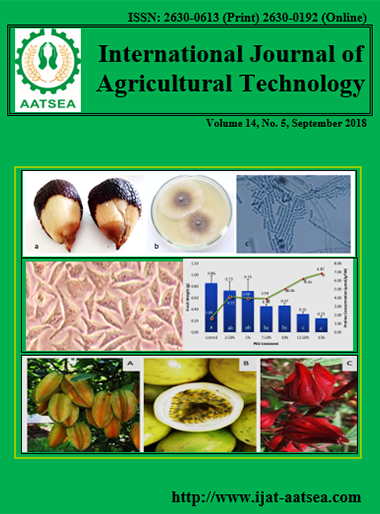Efficacy of Four Different Feeds for Producing Hatchery Raised Red Claw Crayfish (Cherax quadricarinatus)
Main Article Content
Abstract
This research was initiated in order to determine effectiveness of locally available Thailand feeds and homemade (domestically manufactured) diets for best production of hatchery raised Red Claw Crayfish (Cherax quadricarinatus). A higher cost commercially manufactured shrimp feed was also examined. Brooding red claw crayfish were individually reared and fattened with four different feed treatments; earthworm segments, oyster meat, homemade mixed feed and commercial shrimp pellet feed. Feeding occured for 30 days, prior to transfer of all red claw crayfish to a pool mating tank. Gravid females for each feed treatment were collected and recorded at 15 day intervals, until day 45 of the breeding period. Total hatchery production for incubation times, number and size of free living juveniles, as well as survival and growth of 1 month old crayfish were determined, comparing performance of all brood crayfish. Results showed that brood crayfish fattened with oyster meat and homemade mixed feed, spawned faster and with higher fecundity, than brood crayfish fattened with earthworm segments and commercial shrimp pellet feed. Brood crayfish fattened with oyster meat spent longest incubation times. However, they gave similarly free living juvenile recruitment numbers to those brood fattened with homemade mixed feed and shrimp pellet feed. Even though the brood crayfish fed homemade mixed feed produced largest sized free living juveniles, juveniles fed with oyster meat showed better overall growth. Brood crayfish fattened with earthworm segments required shortest incubation times and produced highest numbers of free living juveniles. However, their free living juveniles were of the smallest size. Therefore, homemade feeds, or oyster meat feeds, are suggested to be the best choice for a maturation feed for red claw crayfish, for breeding. A better production performance, lower cost and simple preparation were observed factors.
Article Details

This work is licensed under a Creative Commons Attribution-NonCommercial-NoDerivatives 4.0 International License.
References
Ahyong, S. T. and Yeo, D. C. J. (2007). Feral populations of the Australian Red-Claw Crayfish (Cherax quadricarinatus von Martens) in water supply catchments of Singapore. Biological Invasions 9:943-946.
Anitha, J. and Jayraaj, I. A. (2012). Nutritional and antioxidant evaluation of earthworm powder (Eudrillus euginae). International Research Journal of Pharmacy 3:177-180.
Apirakpongsa, C. (2013). Red Claw Crayfish, freshwater lobster, Research Successful of the Royal project foundamental. Kasetfocus 11:24-25.
Bureau of Nutrition (2014). Cholesterol and Fatty acid in Thai food. Department of Health, Ministry of Public Health Thailand. 53 p.
Christina, C. B., Jason, Q. H. W., Darren, C. J. , Tan, S. H., Heok, H. T., Esther, C. and Peter, A. T. (2011). Ornamental trade as a pathway for Australian redclaw crayfish introduction and establishment. Aquat Biol 12: 69-79.
Edgerton, B. F. (2005). Freshwater crayfish production for poverty alleviation. World Aquac 36:48-64.
Edwards, C. A. (1985). Production of feed protein from animal waste by earthworms. Philosophical Transactions of the Royal Society of London Series B 310:299-307.
Egwurugwu, J. N., Ifedi, C. U., Uchefuna, R. C., Ezeokafor, E. N. and Alagwu, E. A. (2013). Effects of zinc on male sex hormones and semen quality in rats. Niger J Physiol Sci 28:17-22.
El-Sayed, A. F. M. and Kawanna, M., (2008). Effects of dietary protein and energy levels on spawning performance of Nile tilapia (Oreochromis niloticus) broodstock in a recycling system. Aquaculture 280:179-184.
Goncalves, I. B., Ahnesj, I. and Kvarnemo, C. (2011). The relationship between female body size and egg size in pipefishes. Fish Biology 78:1847-1854.
Harrison, K. E. (1990). The role of nutrition in maturation, reproduction and embryonic development of decapod crustaceans: a review. Shellfish Res 9 :1-28.
Jiang, M., Wu, F., Huang, F., Wen, H., Liu, W., Tian, J., Yang, C. and Wang, W. (2016). Effects of dietary Zn on growth performance, antioxidant responses, and sperm motility of adult blunt snout bream, Megalobrama amblycephala. Aquaculture 464:121-128.
Ladan Asgari (2004). Broodstock nutrition of Australian red claw crayfish Cherax quadricarinatus (von martens). Dissertation Thesis of University Putra Malaysia, Faculty of agriculture 1-72.
Lodge, D. M., Deines. A., Gherardi. F., Yeo D. C. J., Arcella, T., Baldridge, A. K., Barnes, M. A., Chadderton, W. L., Feder, J. L., Gantz, C. A., Howard, G. W., Jerde, C. L., Peters, B. W., Peters, J. A., Sargent, L. W., Turner, C. R., Wittmann, M. E. and Zeng, Y. (2012). Global introductions of crayfishes: evaluating the impact of species invasions on ecosystem services. Annual Review of Ecology, Evolution and Systematics 43:449-472.
New, M. (2003). Responsible aquaculture: Is this a special challenge for developing countries?. World Aquac 34:26-31.
Saound, I. P., De Yta, A. G. and Ghanawi, J. (2012). Nutritional Biology and Dirtary Requirements of Redclaw Crayfish Cherax quadricarinatus (Von Martens 1868). Aquacultur Nutrition 18:349-368.
Wilson, R. P. (2002). Amino Acids and Proteins. In: Fish Nutrition. Eds., Halver, J.E., Hardy, R.W. Third edition, Academic Press 144-181.


